Alchemy is an area of study, sometimes described as a science, sometimes described as a branch of philosophy, that was practiced in Europe, Asia, and Africa. Alchemy originated in the early centuries AD, primarily in Egypt, Greece, and Rome, but eventually spread as far as India, China, and England by the 12th century.
Alchemists had three main goals:
Create the Philosopher’s Stone (a legendary substance said to be capable of transforming lead into gold and giving the user eternal life)
Create an elixir of eternal youth and health
Transmute metals (specifically into gold)
Achieving any one of these goals would cause the alchemist to become incredibly rich and famous and, as a result, many would-be alchemists used trickery or outright lied about their findings, eventually tarnishing the concept of alchemy and linking it to the idea of fraud. Improved scientific knowledge, particularly in chemistry, also lead to alchemy’s decline in the 18th and 19th centuries as scientists learned many of the goals of alchemy weren’t possible.

The symbol for the philosopher's stone
How Have Alchemy Symbols Been Used?
Since the beginning of alchemy, alchemists have used symbols to represent different elements. Alchemy symbols sometimes contain hints of the qualities the element was thought to have, as well as the history of the element. Using symbols helped alchemists keep their work, much of which was carefully guarded, secret from non-alchemists who wouldn’t recognize the symbols.
Because early alchemy also drew much of its information from astrology, many alchemy element symbols are connected to planets or other celestial bodies. Alchemy symbols continued to be used until the 18th century, becoming more standardized as time went on. Today, people enjoy alchemy symbols for their history, interesting shapes, and connection to a different way of thinking about the world.
22 Alchemy Symbols and Their Meanings
Below are the four main groups of alchemy element symbols, along with their meanings.
The Three Primes
The three primes, also known as the tria prima, were named by Paracelsus, a Swiss philosopher, in the 16th century. He believed the tria prima contained all the poisons that caused disease, and that by studying them, alchemists could learn how to cure disease. He also believed the tria prima defined humans, and he assigned each of the elements to a different part of the human identity.
Mercury

Mercury (which is also one of the seven planetary metals) can mean both the element and the planet. In either case, this alchemy symbol represents the mind, as well as a state that could transcend death. In ancient times, mercury was known as quicksilver, and it was believed to be able to shift between liquid and solid states. Therefore, in alchemy, mercury was believed to shift between life and death.
Mercury is often represented by a serpent/snake, and its symbol is said to resemble a cosmic womb. Mercury is also sometimes said to represent the passive female principle, as well as wetness and cold. You can see the standard “female” sign within its symbol.
Salt

Salt is now known to be a chemical compound comprised of sodium and chloride, but alchemists believed it was a single element. Salt represents the body, as well as physical matter in general, crystallization, and condensation. Salt is often impure when first collected, but through chemical processes it can be dissolved and purified, which some alchemists compared to purification processes the human body can undergo. Its symbol is a circle bisected by a horizontal line.
Sulfur

Sulfur, also known as brimstone, is the active male counterpart to mercury’s passive female representation. In antiquity, it was used as traditional medicine in places ranging from China to Egypt to Europe. It’s mentioned in both the Torah and the Bible, the latter of which states that Hell smells like sulfur.
Sulfur represents properties such as dryness, heat, and masculinity. In alchemy, it could also represent evaporation, expansion, and dissolution. In terms of human body, it represented the soul. In terms of the tria prima, sulfur was seen as the middling element connecting salt (high) and mercury (low).
Sulfur’s symbol is typically a triangle atop a Greek cross (seen above), but it can also be represented by a Cross of Loraine atop an ouroboros/infinity symbol. This symbol has come to be known as Satan’s Cross and is sometimes used as a satanic symbol.
The Four Classical Elements
The Classical Elements are based on the ancient Greek belief that air, earth, fire, and water composed all matter in the world. Unlike many of the other elements in this guide, these four aren’t elements you can find on the periodic table, but alchemists believed to have significant powers, as well as the ability to create new elements.
Medieval Arab alchemist Jabir ibn Hayyan was one of the first to connect the four elements to alchemy, but the classical elements were well-studied in ancient Greece before that. The ancient Greek physician Hippocrates connected each to one of the four humours of the human body, while Aristotle connected each to a principle of heat/cold and dryness/moisture.
Air
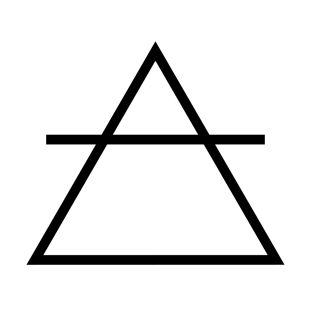
Aristotle stated that air represented heat and wetness (the wetness is from water vapor, which was thought to be part of air). The air symbol in alchemy can also represent a life-giving force, and it is associated with the colors white and blue. Hippocrates associated air with blood. Air’s symbol is an upward triangle bisected by a horizontal line, and you might notice it is the Earth symbol, inverted.
Earth

Aristotle labeled Earth as cold and dry. Earth can represent physical movements and sensations, and it’s associated with the colors green and brown, and the humor black bile. Earth’s symbol is the inverse of air’s: a downward-point triangle bisected by a horizontal line.
Fire

In alchemy, fire represents emotions such as passion, love, anger, and hate, which are sometimes referred to as “fiery” emotions. Aristotle labeled it as hot and dry, and it is represented by the colors red and orange, as well as the humor yellow bile. Additionally, fire is also seen as a more masculine symbol. The fire alchemy symbol is an upward-pointing triangle.
Water

Aristotle labeled water as cold and wet, and Hippocrates connected it to the body humor phlegm. Additionally, it’s associated with intuition as well as the color blue, and is often linked to the alchemy symbol of mercury (as both are seen as feminine symbols). The Greek philosopher Thales believed water was the first substance created in the world.
As another contrast to fire, the water alchemy symbol is the inverse of the fire symbol; a downward-point triangle. This symbol is sometimes said to resemble containers for holding water, such as a cup or urn.
The Seven Planetary Metals
Each of these elements is a metal, and they are each connected to a celestial object, as well as a day of the week and an organ in the body. Astronomy was a major part of early alchemy, and during the classical era, each planet was thought to “rule” over its associated metal, with its position in the sky and proximity to other planets affecting the metal’s properties.
You might notice that Uranus and Neptune aren’t included; that’s because these symbols were created before telescopes were invented, and thus only planets visible to the naked eye were known to exist.
Lead

- Celestial body: Saturn
- Day of the week: Saturday
- Organ: Spleen
Lead (known as plumbum in classical times) has a symbol known as a “crescent below the cross,” and it looks similar to a scythe or a stylized “h” with a cross on top.
Tin

- Celestial body: Jupiter
- Day of the week: Thursday
- Organ: Liver
Tin’s symbol is known as a “crescent below the cross,” and it looks like a stylized “4”.
Iron

- Celestial body: Mars
- Day of the week: Tuesday
- Organ: Gallbladder
The “male” symbol often used to represent the planet Mars is the alchemy symbol for iron.
Gold

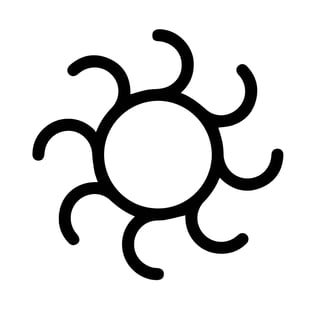
- Celestial body: Sun
- Day of the week: Sunday
- Organ: Heart
Gold represented perfection, and it was one of the most prominent symbols in alchemy. A key (and unfulfilled) goal of many alchemists was to learn how to turn lead into gold. Two symbols can represent the gold alchemy symbol. The first looks like a stylized sun with rays emitted from it, and the second is a circle with a dot in its center.
Copper
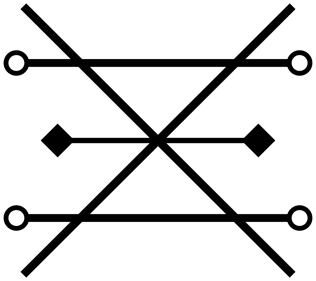

- Celestial body: Venus
- Day of the week: Friday
- Organ: Kidneys
The symbol for copper can be either the “female” symbol (also used to represent the planet Venus) or a set of crossed and horizontal lines.
Mercury

- Celestial body: Mercury
- Day of the week: Wednesday
- Organ: Lungs
Mercury has the same symbol it has when it’s part of the Three Primes: the “cosmic womb.”
Silver

- Celestial body: Moon
- Day of the week: Monday
- Organ: Brain
Silver’s alchemy symbol looks like a crescent moon, the same way gold’s symbol looks like a small sun. The crescent can be drawn facing either the right or the left.
Mundane Elements
The mundane elements make up the rest of the elements used in alchemy. They are typically more recent additions to alchemy, and they don’t have as long a history as some of the other elements. As a result, less information is known about their alchemy symbols and what they represent, although all were used by alchemists at some point.
Antimony

Antimony represents the wild/animalistic parts of human nature. Antimony’s symbol is a circle with a cross above it (or the upside-down female symbol), and it is also sometimes represented as a wolf.
Arsenic

In alchemy, arsenic is often represented by a swan or swans. This is because, as a metalloid, arsenic is capable of transforming its physical appearance (a metallic-gray solid or a yellow crystalline solid), the same way a cygnet transforms into a swan. Its symbol is a pair of overlapping triangles.
Bismuth

Not much is known about how bismuth was used in alchemy, but until the 18th century, it was often confused with tin and lead. Its symbol looks like an “8” that is open at the top.
Magnesium
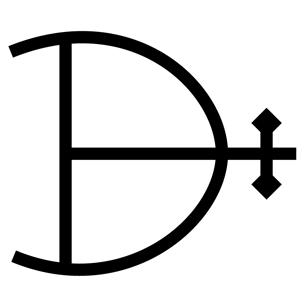
Magnesium isn’t found in its pure form, so alchemists used magnesium carbonate (also known as “magnesium alba”) when conducting experiments. Because magnesium can’t be extinguished easily once it has been ignited, it represented eternity to alchemists. Several symbols can represent it; the one above is the most common.
Phosphorus

Phosphorus was an important element for alchemists because it appeared to have the ability to capture light. (When the white form of phosphorus oxidizes, it glows green.) It represented the spirit, and its symbol is typically a triangle atop a double cross.
Platinum
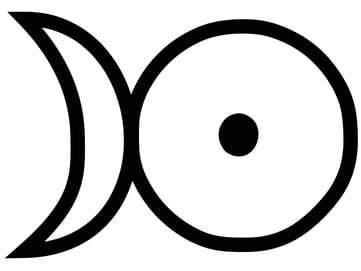
Alchemists believed platinum was a combination of gold and silver, which is why its symbol is the combination of the symbols of each of those elements.
Potassium
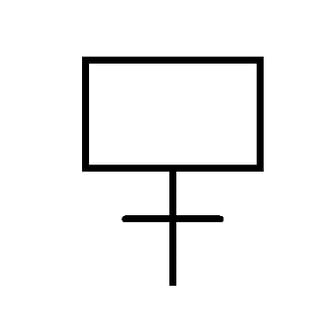
Potassium isn’t naturally found as a free element, so alchemists used potassium carbonate, often known as “potash,” in their experiments. The symbol for potassium is a rectangle atop a cross.
Zinc

Alchemists burned zinc to create zinc oxide, which they called “philosopher’s wool” or “white snow.” Multiple symbols can represent zinc; the most common is shown above.
No comments:
Post a Comment